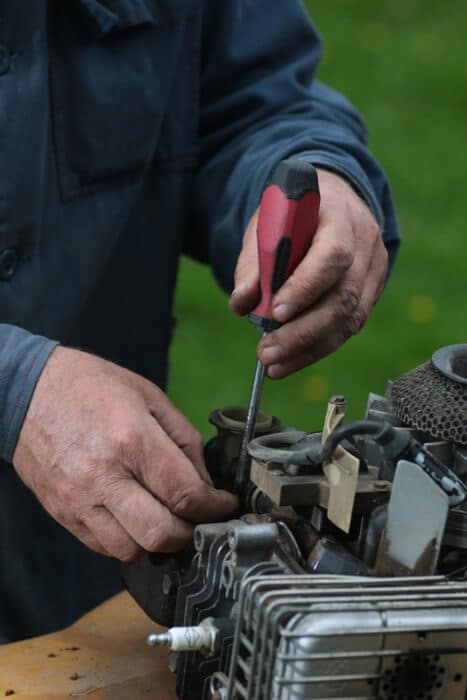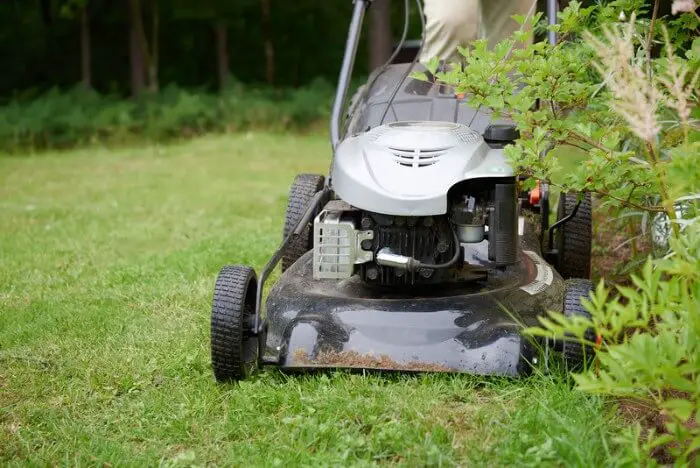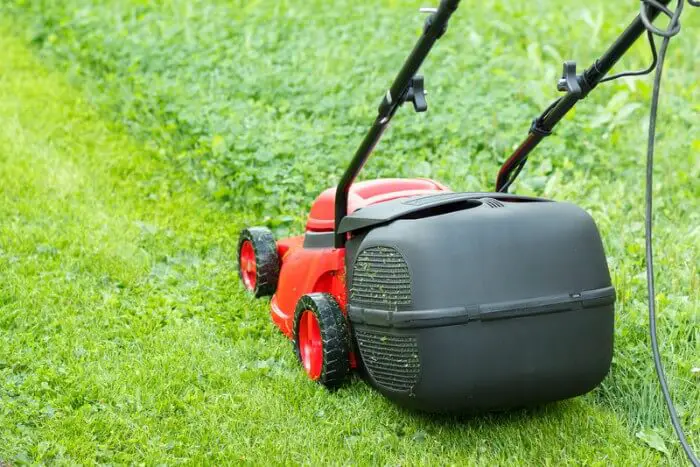Lawnmowers often make a lot of noise (up to 95dB) due to their engine or the blades, noise can be considerably reduced by repairing and replacing worn parts or fitting sound deadening material to the lawnmower deck.
Use our step by step guide to make your lawnmower quieter today.
Main Sources of Noise on a Lawnmower
There are 4 main sources of noise from a lawnmower, these are:
- Engine
- Exhaust
- Mechanical vibrations – the mower will vibrate and radiate sound.
- Blade – the blade that cuts the grass will be moving fast causes the air to move and generate noise.
When we look at reducing the sound of a lawnmower these are the areas that need to be focussed on. Below are 4 effective ways to make a lawnmower quieter:
1. Check the Muffler
The muffler is designed to reduce engine noise. The hot exhaust gases pass through the muffler to reduce the noise and prevent sparks from flying from the exhaust.

It is quite common for mufflers to build up with soot or become cracked or develop holes over time.
If your lawnmower is producing a lot of noise it could be something to do with the muffler being worn or damaged.
To check and change the muffler, follow these steps:
- Allow the engine to cool down for a few hours. Do not try this after recently using the lawnmower as the exhaust pipe and muffler will be extremely hot and can burn you.
- Locate the exhaust pipe. Using the right-sized wrench, you will need to unscrew the bolts holding the exhaust pipe to the lawnmower.
- Remove the exhaust pipe to gain access to the muffler.
- With the exhaust pipe removed, you can now see the muffler. Inspect it for damage including cracks and rust.
- Remove the muffler by undoing the mounting bolts. It is common for the muffler to become worn over time which then causes the engine to sound considerably louder. Take care if the muffler is rusty as it can easily break or collapse under pressure so it is best to use pliers to hold it when you are removing it to avoid injuring yourself.
- With the muffler removed you will be able to check for internal damage. The easiest and quickest way to do this is by shaking it or tapping it against a hard surface. You will be able to hear if the inside has deteriorated as there should be no noise when you shake a muffler that is in good condition. If there is a lot of noise and debris coming from inside then the muffler needs to be replaced.
- If you find the muffler is in good condition, carefully reattach it. If you find damage, wear and tear or signs of internal deterioration then the effectiveness of the muffler has been restricted and it is best to replace it with a new high-quality muffler. When choosing a new muffler, keep in mind that longer mufflers are quieter so choose a longer one if possible.
- Remove the old gasket from the exhaust port and scrape away any debris and carbon build-up. Once the area is clean, fix a new gasket in place over the exhaust port.
- Finally, check the exhaust pipe for damage before tightening it back in place. If you do find damage, you may need to repair or replace it. With this maintenance and repair work complete, the lawnmower should be quieter when in use.
A professional can help you make these repairs and changes if you don’t feel confident doing it yourself.
Remember: never try to work on the exhaust or muffler after the lawnmower has been on as it will be hot to touch and can cause severe burns.
2. Soundproof the Deck
Although the muffler is now doing its job as it should, you might still find your lawn mower makes a racket every time you use it. This will be because of the noise the blades are making as they move.
Fortunately, there are ways of reducing the amount of noise that is coming from the deck (common noises include the blade, vibration and rock pings).
While there isn’t much you can do to actually silence the blades themselves, you can muffle the noise using sound deadening mats.

- Choose a material to soundproof the deck. The best bet here is sound deadening mats as they are light, flexible and effective. There are a range of sound-deadening options available and you can actually use the same materials that are used for soundproofing vehicles.
- Cut the material to size. Soundproofing material is generally thick, affordable and comes in sheets. Soundproofing mats are usually lightweight too so they won’t add extra weight to your lawnmower.
- Scrub any dirt and debris off the top of the deck to ensure the soundproof material can be neatly and effectively attached.
- Attach the soundproofing mat to the top of the deck. Self-adhesive mats are quicker and easier to apply as it does not require any other adhesive to attach it and they do not come off easily after installation. When installing a self-adhesive soundproofing mat, all you need to do is peel the protective backing away and press the mat down onto the deck. That’s it!
The soundproofing mats on the deck will reduce rattles and vibrations.
Be careful: do not apply the material in a way that will block airflow and cause damage.
3. Change Lawnmowers
Most lawn mowers are quite loud, even when they are working at their best.
There are a few lawnmowers that have been designed to be quieter but these tend to be few and far between.
Below are two things to look out for if you are choosing a new quiet lawn mower:
- Switching from a gas-powered engine to an electric mower is a great way to reduce the noise experienced. This is an effective option if soundproofing and maintaining your lawnmower is going to be expensive. While still not silent, electric lawnmowers are quieter and make cutting the grass an enjoyable, stress-free experience.

- You may also want to look at mowers with smaller engines as these produce less noise than larger engines.
4. Protect Your Ears
A lawnmower is very loud, particularly when you are the one operating it.
It is extremely important to wear earmuffs to protect your eardrums while using the mower, even if you manage to reduce the noise level with the above suggestions.
It may feel unnecessary to wear earmuffs but extended exposure to loud noise can permanently damage your inner ear.

A lawnmower produces noise of 75dB – 90dB and if the lawnmower is not well-maintained the noise can be even louder.
Hearing loss caused by a lawnmower is gradual, it happens over time which is why you may think it is safe to not protect your ears.
Many people experience hearing problems and partial deafness as a result of working with loud machinery, this can be avoided by wearing the right personal protective equipment.
Earmuffs and earplugs are an affordable way to protect your hearing. They will muffle the sound considerably and will prevent blowing your eardrums.
- Earmuffs – earmuffs cover your ears completely, they are easy to use and tend to be inexpensive.
- Earplugs – these are inserted into your ears, they sit in the ear canal and create a seal.
Summary
It is possible to make a lawnmower quieter by keeping it properly maintained and by fitting soundproofing material to the deck. As lawnmowers are naturally quite loud machines it is really important to always wear ear protection when you are mowing the grass.
This will protect your eardrums and ensure you do not experience partial deafness as a result of using the lawnmower over a period of time.
Use the tips in this guide to ensure you can keep your lawns looking great without worrying about disturbing the neighbours.
If you find that repairing, maintaining or soundproofing your current lawnmower is going to be expensive, it may be worthwhile to invest in a new electric mower to save you money in the long run.
As an Amazon Associate I may earn a small fee from qualifying purchases at no extra cost to you. This helps us run the site, so thanks for your support!